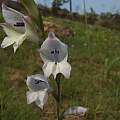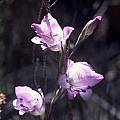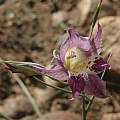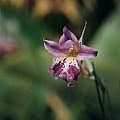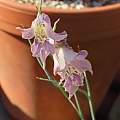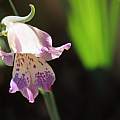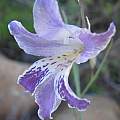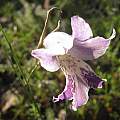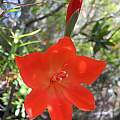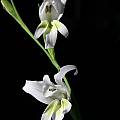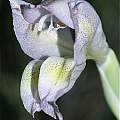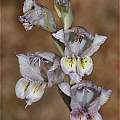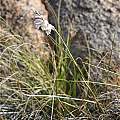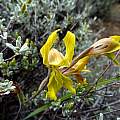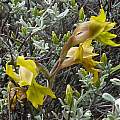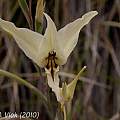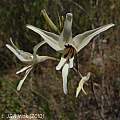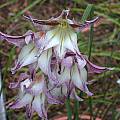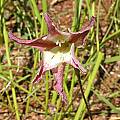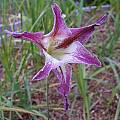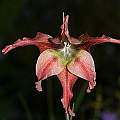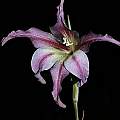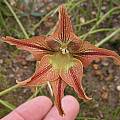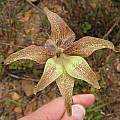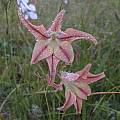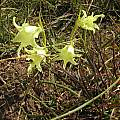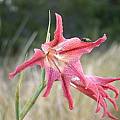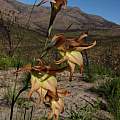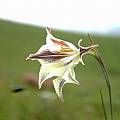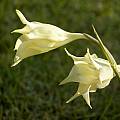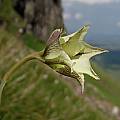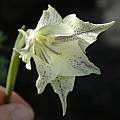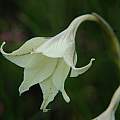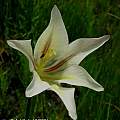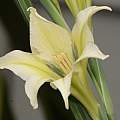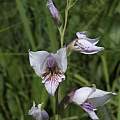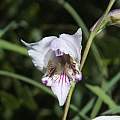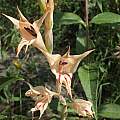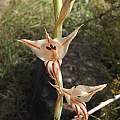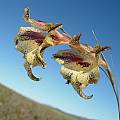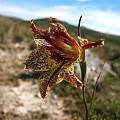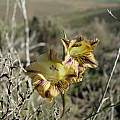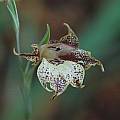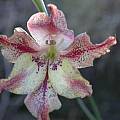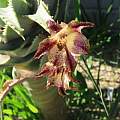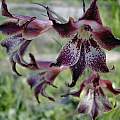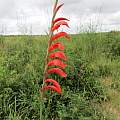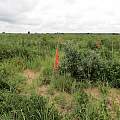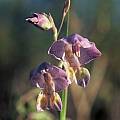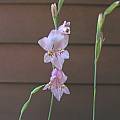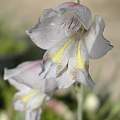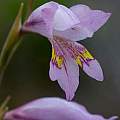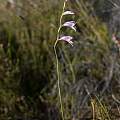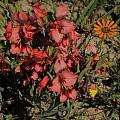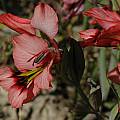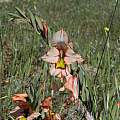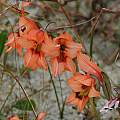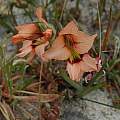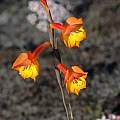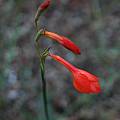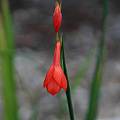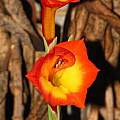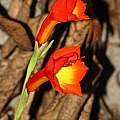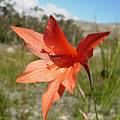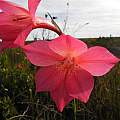There are about 163 species of Gladiolus (with new ones being discovered) in the area south of the Tropic of Capricorn and including Botswana, Lesotho, Namibia, South Africa, Swaziland, and Mozambique. Some are found in winter rainfall areas and some in summer rainfall areas. For more information see Goldblatt and Manning, 1998. Southern African species from I-Me are pictured on this page.
Gladiolus index - Southern African Gladiolus A-B - Southern African Gladiolus Ca - Southern African Gladiolus Ce-E - Southern African Gladiolus F-H - Southern African Gladiolus Mi-Pa - Southern African Gladiolus Pe-R - Southern African Gladiolus S-T - Southern African Gladiolus U-Z - Gladiolus Hybrids - Miscellaneous Gladiolus
Gladiolus inandensis Baker is a species that grows in small clumps to 20 to 45 cm. It is mostly found on sandstone soils in KwaZulu-Natal and the Eastern Cape, but it also has been recorded in Lesotho. Plants are found on rocky grassland and flower early in the summer rainfall region, mostly July to August, extending into September. This species has small white to cream flowers flushed with purple on the outside of the tepals. The dorsal tepal is hooded over the stamens. This species is unusual in that the flowers are usually produced before the new leaves on short stems with the dry dead previous foliage leaves attached to their base. This species is very similar to Gladiolus wilsonii but that species produces a stem after the new leaves are produced and flowers at a different time. Photo from Rachel Saunders.
Gladiolus inflatus Thunb. grows in open habitats on sandstone, often in rocky outcrops or in stony ground among shrubs and restios in the mountains of the Western Cape. It has pink to mauve, purple or violet short tubed flowers. The lower tepals have dark spear or spade shaped purple to red marks in the middle third. The mark on the lower median tepal is usually yellow in the center. This species blooms in spring. Height range: 25-60 cm. Photo taken by Rod Saunders.
Gladiolus inflexus Goldblatt & J.C.Manning is endemic to only a few places in the Southwestern Cape where it grows in sandstone derived gravel. Growing from 20 to 35 cm, it has 1 to 3 purple flowers formed on a wiry bent stem. The sweetly scented flowers have a strongly arched dorsal tepal and a large lower median tepal that is greater than the lower laterals. The bases of the tepals and the throat are cream with the lower tepals speckled to blotched purple. Flowering time is mid to late July, sometimes into August. The first photo was taken by Rachel Saunders. The next three were taken by Alan Horstmann.
The next three photos from iNaturalist were taken by Douglas Euston-Brown in July near Worcester and shared under a CC BY-SA license.
Gladiolus insolens Goldblatt & J.C.Manning grows in a few wet sites along streams and seeps in rocky areas on the higher slopes of the Piketberg in the western Cape. It has a spike of one to three bright scarlet flowers and five to seven narrow grey green leaves. Height range: 30-50 cm. Photo by Rachel Saunders.
Gladiolus involutus D.Delaroche is found on clay slopes in renosterveld and grassland in areas with summer and winter rainfall. Flowering from winter into spring, it has white flowers with yellow-green markings on the lower tepals. Height: 30-50 cm. Photo by Bob Werra.
Gladiolus kamiesbergensis G.J.Lewis grows in rocky sites in shrubby fynbos in the Kamiesberg of central Namaqualand. From 45-90 cm tall, this species has small, pale, lilac flowers with minute purple dots within and on the reverse of the tepals. The lower lateral tepals are yellow on the lower half of the limbs. This species flowers in spring and the flowers are sweetly scented and probably pollinated by long-tongued bees. Photos taken by Andrew Harvie.
Gladiolus karooicus Goldblatt & J.C.Manning was named in 2009. It is found from the Little Karoo to the Komsberg section of the Roggeveld Escarpment. Photos taken September 2011 by Cameron McMaster near Matjiesfontein.
Gladiolus leptosiphon F. Bolus is an uncommon species from South Africa that occurs from Ladismith in the Little Karoo to Uitenhage in the Eastern Cape where it is found on stony hills and low mountain slopes in renosterveld or arid fynbos. It is threatened by ongoing habitat loss to agricultural expansion, particularly ostrich farming but also crop cultivation. Plants grow up to 60 cm tall with narrow whip like leaves and 6-9 creamy white flowers marked with dark red-purple lines on the lower three tepals and a long slender tube. The upper three tepals are largest, the dorsal suberect and the lower tepals narrow, channeled, arching downward. Flowering is in spring (October to November). Pollination is by a long-tongued fly. Photos from the book Plants of the Klein Karoo courtesy of Jan and Anne Lise Schutte-Vlok.
Gladiolus liliaceus Houtt. grows on clay slopes over a wide area of South Africa (from the Cedarberg Mountains to Port Elizabeth) and blooms winter to spring. Growing from 30 to 80 cm high, the 1 to 4, sometimes 6, flowers are an inclined spike. The large flowers are brown, dull pinkish red, tan, purplish or cream to greenish yellow and turn bluish to mauve in the evenings when they become intensely clove scented. Depending on the location and the elevation with the lower elevations blooming earlier, this species blooms from late August to December.
The ones grown by Mary Sue Ittner have not been very fragrant and the color change is subtle. Photo 1 was taken by Mary Sue Ittner. Photos 2-3 from Bob Rutemoeller attempt to show the change in color. Photo 2 was taken during the day and photo 3 in the early evening. Andrew Harvie's photos (4-5) show the orangey red color of the day and the more purple color of the night. To ensure correct color balance both photos were taken with a flash and same exposure. He notes that he wishes he could also share the fragrance.
The forms pictured below in the first four photos were all found at Drayton and were blooming August-September 2003. Photos by Bob Rutemoeller including a single yellow one. The fifth photo is of a red flowered one photographed by Cameron McMaster near Bredasdorp in the Overberg. The last photo from the book Plants of the Klein Karoo courtesy of Jan and Anne Lise Schutte-Vlok.
Gladiolus longicollis Baker is a species found in a wide area of southern Africa, including the southern Cape, the eastern Cape, the Free State and the Northern Province. It has pale yellow to white long tubed flowers that are either uniformly colored or mottled with brown. Flowers are night blooming and sweetly scented of carnation and cloves. Height range: 35-60 cm. There are two subspecies:
Gladiolus longicollis ssp. longicollis has a shorter perianth tube and transparent upper tepals and flowers October to November. It is found from Oudtshoorn in the Western Cape through the Eastern Cape and Free State and into Lesotho and Gauteng where it usually grows on moist, south facing slopes in low grassy fynbos or rocky grassland.
Gladiolus longicollis ssp. platypetalus (Baker) Goldblatt & J.C.Manning has a longer perianth tube and broader petals with the outer whorl tepals longer than the inner whorl and grows in rocky grasslands from central KwaZulu-Natal to Mpumalanga and Limpopo. Its flowering season extends into January and possibly February.
The first three photos from Cameron McMaster and the next two from Mary Sue Ittner. Photos three thru five were taken at Naude's Nek.
The first photo from the book Plants of the Klein Karoo courtesy of Jan and Anne Lise Schutte-Vlok. They describe it as growing up to 60 cm tall with narrow cylindrical leaves and flowers with red brown spots and lines. The anthers are not much exposed, a characteristic that helps distinguish it from a similar looking Gladiolus tristis. The second photo is from Arnold Trachtenberg.
Gladiolus loteniensis is a narrow endemic known only from the upper Loteni River valley in KwaZulu-Natal. It grows in flat sites along the riverbank in black peaty soil and in the lee of low cliffs or boulders. Growing from 30 to 60 cm high, it has 4 to 7 leaves. The lower and longest basal leaves are narrowly lanceolate to linear with a lightly thickened and raised midrib and the remaining leaves are inserted between the middle and upper quarter of the stem and are channelled. Flowering occurs early December to mid January with a straight to slightly flexed spike of 6 to 12 unscented pale lilac short tubed flowers. The lower three tepals are veined violet on a cream to pale yellow background in the lower two thirds; the upper third is pale or dark lilac. Photos taken by Rachel Saunders December 2014.
Gladiolus macneilii Oberm. is a narrow endemic of the eastern escarpment of northern Mpumalanga, South Africa where is grows in loamy soil in rocky ground in grassland and light woodland. Growing from 70 to 90 cm with a slightly inclined spike of 7 to 17 flowers, it blooms in March and April. Flowers have a very long perianth tube (40 to 45 mm) and are cream to pale salmon pink, each with a narrow, dark red, longitudinal median streak. The upper three tepals are the largest with the dorsal tepal arching over the stamens and the lower three tepals are united at the base with narrow and recurving tips. The anthers have short appendages and long purple tails. Photos by Rachel Saunders.
Gladiolus maculatus Sweet extends across the southern coast and immediate interior of the winter rainfall area to the Eastern Cape where it is often found growing in heavy soils in renosterveld. Flowers are dull yellow to lilac and speckled with brown or purplish spots. They are long-tubed and fragrant during the day and the evening. Height range: 30-60 cm. The first three pictures were taken by Cameron McMaster near Napier and Bredasdorp in the Overberg.
The first two pictures below are of garden flowers taken by Mary Sue Ittner December 2007 and January 2009. The next two were taken by Alan Horstmann and the last by Dirk Wallace.
Gladiolus magnificus (Harms) Goldblatt is a southern tropical African species found from central Angola through southern Zambia to western Zimbabwe. It is also found in the northern edges of Namibia and Botswana. In the past this species has been included in Antholyza under three species names as well as being included in Chasmanthe and Oenostachys. It has bright red flowers with a long perianth tube and reduced lower tepals with yellow markings. Tepals are very unequal with the dorsal the largest, hooded and horizontal. The laterals are broadly lanceolate and directed forward. Height range: 80-140 cm. It flowers in January and February. Photo from iNaturalist taken by Cody Coyotee Howard in Namibia and shared under a CC BY-NC license.
Gladiolus marlothii G.J.Lewis is endemic to the Roggeveld Escarpment. It grows on open slopes or among rock outcrops, always in heavy clay and usually in rocky situations at an elevation of 1800 m. Flowers are pale blue-lilac with a transverse yellow band about the base of the limb and are densely speckled with dark purple at the edges of the yellow band. Height range: 45-60 cm. Photograph taken by Rod Saunders.
Gladiolus martleyi L.Bolus syn. Gladiolus pillansii grows on sandy and rocky flats in the northern and southwestern Cape and blooms in the fall on a flowering stalk without leaves. Growing from 30 to 60 cm, it has usually scented pale to pink or lilac flowers. The lower lateral tepals each have a transverse band or a spear shaped yellow mark edged darker pink or purple in the upper half. The first photo by Bob Rutemoeller shows one grown from IBSA seed from Betty's Bay. The second photo was taken by Dirk Wallace. Other photos taken by Christopher Whitehouse in the Phillipskop Mountain Reserve.
Gladiolus meliusculus (G.J.Lewis) Goldblatt & J.C.Manning, syn. Gladiolus alatus var. meliusculus is found on low hills and flats on the western Cape coastal plain where it grows in sandy sites formed from decomposed granite or sandstone that are waterlogged during the period of growth. Flowers are salmon, brick-red or orange with yellow markings on the lower tepals. Gladiolus meliusculus differs from Gladiolus alatus by having shorter stamens and the yellow on the lower tepals is less pronounced and edged by a band of red-purple and the upper halves are pink to orange. Height: 12-25 cm. The first three photos were taken by Mary Sue Ittner and Bob Rutemoeller September 2006 near Darling. The other two were taken near Brackenfell on Rod and Rachel Saunders' property where they are growing this species.
Gladiolus merianellus (L.) Thunb. is a species that has had many different names and settled for a while under Gladiolus bonaespei Goldblatt & M.P.de Vos (originally spelled bonaspei). Other synonyms are Homoglossum merianellum (Thunb.) Baker, Homoglossum merianellum (Thunb.) Baker var. aureum G.J.Lewis, and Petamenes pilosus (Klatt) Goldblatt. It has also been known as Watsonia pilosa Klatt. This species grows on sandy flats and slopes in the Southwest Cape. It has 2 to 7 orange, rarely yellow flowers. Flowers held up very well during a wet period in February when they bloomed and over the course of the blooming period the color changed slightly from all orange to orange with yellow tones. Height range: 30-50 cm. The first photo is from Rod Saunders. The next three photos are from Mary Sue Ittner and the following two are by Dylan Hannon of the first flowering of his seed-grown plants 10 years after sowing.
Gladiolus meridionalis G.J.Lewis is found in the Southern Cape from the Overberg to Port Elizabeth (both winter and summer rainfall areas) and flowers from June to August. The distribution is discontinuous. Plants grow in stony sandstone soils in low fynbos on mountain slopes and flats that are usually in sight of the ocean. The populations in the west of the range have dark pink to salmon flowers and those in the east have cream to pinkish orange flowers. Flowers are adapted for pollination by sunbirds with a long perianth tube. An article here describes a rare finding of this species. Height: 35-45 cm. The first photograph from Cameron McMaster was taken on the farm Fairfield in the Napier district where it occurs on sandstone slopes. The second photo was taken by Rachel Saunders.
Gladiolus index - Southern African Gladiolus A-B - Southern African Gladiolus Ca - Southern African Gladiolus Ce-E - Southern African Gladiolus F-H - Southern African Gladiolus Mi-Pa - Southern African Gladiolus Pe-R - Southern African Gladiolus S-T - Southern African Gladiolus U-Z - Gladiolus Hybrids - Miscellaneous Gladiolus
